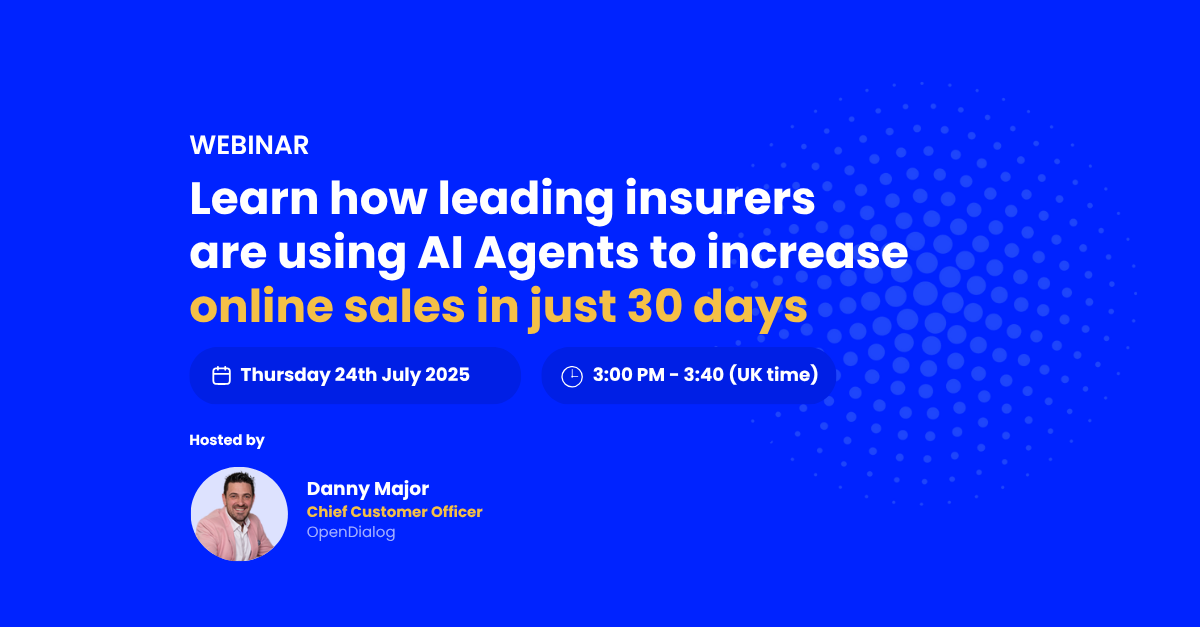Picture this: you’re waiting for an insurance quote, but you’re number ten in a queue on the phone. You don’t have the time for this, so you go to another insurance provider who can assist you with an AI-powered chatbot. The wait time is three seconds, instead of thirty minutes. That insurance provider has just lost you to a competitor by failing to keep up with AI technology.
Staying competitive means embracing innovation that enhances customer experiences, streamlines operations, and drives business growth. Conversational AI is a game-changer for the insurance sector, offering a myriad of use cases that deliver tangible results, including lowering your operating expense ratio, improved underwriting profit, and collecting thousands of user data points that can be used to personalize quotes and detect fraud.
This blog explores some of the top use cases for conversational AI that are revolutionizing the insurance industry, and ways that insurers are using the technology to improve efficiency, customer satisfaction, and more.
Use conversational AI to stay ahead of the competition or risk falling behind in a competitive market. Here’s how:
What is Conversational AI?
Conversational Artificial Intelligence, or conversational AI, refers to the use of AI technologies such as natural language processing (NLP), machine learning, and large language models (LLMs) to enable machines to understand, interpret, and respond to human language in a conversational manner. Examples of this include the generative AI chatbot, ChatGPT, that took the world by storm, and enterprise-grade conversational AI platforms like OpenDialog.
If you’d like to delve into more detail about how it works and understand its relationship to generative AI, check out our guide to conversational AI.
How can Insurance Companies use Generative AI?
Insurance company executives may be wondering how they can leverage Generative AI. Will it drive business growth, and ultimately improve their bottom line?
In the insurance sector, investing in conversational AI chatbots or virtual assistants, that use generative AI, increases efficiencies in customer service, reduces wait-times, and improves customer experiences. AI-driven systems are designed to engage in natural language conversations with customers, policyholders, and internal staff, ultimately bridging the gap between technology and human interaction.
What are the Benefits of Conversational AI in the Insurance Industry?
The benefits of conversational AI in insurance are tangible, including:
- Increased efficiencies for both the business and its customers
- Higher conversion and retention rates
- Personalized recommendations based on needs and preferences
- Reduced costs as automated technology replaces the need for a customer support team
- Collection of thousands of user data points within each conversation
What are the Use Cases of Conversational AI in the Insurance Industry?
The use cases of conversational AI in the insurance industry are extensive and have significant implications for businesses. Here are our top ten, and the business outcomes associated with each.
1. Customer Support
If you’re wondering where to start with conversational AI, providing customer support by using an AI chatbot to provide general support and answer frequently asked questions for your customers is one of the best use cases for conversational AI in the insurance sector.
75% of customers expect companies to leverage new technologies to improve customer support. That’s right, a staggering three quarters of your customer base want you to use technology to bring them the best experience possible.
Not only will conversational AI chatbots deflect pressure away from your busy call center, it will also reduce customer wait times and provide 24/7 virtual assistance for policy inquiries, policy changes, and general support. Conversations can be personalized to the user through systems integrations and assist them in understanding their premium payment options, setting up automated payments, and addressing any issues related to billing or payment.
Business outcome: Improve customer service availability while reducing operational costs.
2. Customer Onboarding
Every business owner knows that customer onboarding is time and resource intensive. So what if you could automate it?
Automate customer onboarding with conversational AI by using generative AI technology to walk your customers through the various steps, from collecting customer information, right through to issuing documentation. You’ll not only reduce onboarding time and increase customer satisfaction, but ensure efficient data collection and policy issuance.
Business outcome: Accelerate customer acquisition and improve first-time user experience, while reducing onboarding costs.
3. Policy Recommendations, Inquiries, and Information Retrieval
Did you know that companies that excel at personalization generate 40 percent more revenue from those activities than those who don’t?
Offer personalized policy recommendations based on customer profiles and needs analysis through generative AI chatbots. By eliminating the need for customer support operatives, you reduce customer wait times, and allow policyholders to enquire about their coverage, premium details, and policy terms through natural language queries.
Business outcome: Increase cross-selling opportunities and customer retention rates.
4. Claims Assistance, Processing, and Updates
Customer satisfaction with insurance providers over the last 12 months, has “plummeted at the fastest rate since 2008”. Stay ahead of the competition and keep customers happy with easy claims assistance and documentation.
You can use conversational AI to allow users to initiate and track the status of their insurance claims, providing real-time updates and assistance in completing necessary documentation. Automate claims processing and provide real-time updates, reducing processing times and enhancing customer trust in a tough market.
Business outcome: Expedite claims resolution and boost customer satisfaction.
5. Risk Assessment
Risk is a major factor when choosing an insurance provider, so to avoid losing uneasy customers, new technologies can put their minds at rest in a relaxed, trustworthy, and conversational manner.
Utilize AI to assess policyholder risks more accurately, optimizing underwriting decisions.
Offer proactive risk assessment by engaging users in conversations about potential risks, providing tips for risk mitigation, and enhancing overall risk awareness.
Business outcome: Lower claim payouts and minimize underwriting losses.
6. Fraud Detection
Identify fraudulent claims and activities through AI-driven anomaly detection. The benefits of using Conversational AI in your fraud detection include:
- Real time detection that’s automated
- Machine learning means that the processes improve with time
- AI for fraud detection frees up employees’ time
- And of course, your business is protected and saves money
Business outcome: Decrease fraud-related losses and maintain trust within the policyholder community.
7. Chatbot for Quotes
Chatbots play a vital role in the future of insurance quotes. Why? Because one negative experience is enough for 50% of users to switch to a competitor. If a conversational AI-powered chatbot can give them a quick and accurate claim within seconds, then you’re not losing them as they angrily put down the phone after waiting to speak to someone for half an hour.
Enable AI chatbots to generate instant insurance quotes, enhancing the customer’s purchasing journey.
Business outcome: Expedite sales cycles and capture potential leads effectively.
8. Compliance Monitoring
Compliance is of utmost importance in insurance, but you may feel cautious about pairing ‘generative AI’ and ‘compliance’ together. However, OpenDialog’s conversational AI platform has been built from the ground up for regulated businesses. That means you can rest assured your business will remain compliant while automating conversations using generative AI.
Automate compliance checks and regulatory reporting to ensure adherence to industry standards. Generative AI can automate compliance processes in real time to ensure regulatory compliance.
Business outcome: Mitigate compliance risks and avoid costly penalties.
9. Customer Feedback Analysis
Analyze customer feedback through AI sentiment analysis to identify areas for service improvement. Generative AI can create a two way communications system between you and the customer: provide a conversational interface to educate policyholders on insurance terminology, coverage details, and frequently asked questions–enhancing their understanding of their insurance–while you increase your understanding of their needs.
Business outcome: Enhance customer experience and loyalty through actionable insights.
10. Predictive Analytics
Is AI just based on hype? No. It’s based on real outcomes for businesses. OpenDialog’s conversational AI platform collects thousands of data points with each customer interaction, enabling you to leverage AI to predict market trends, customer behavior, and risk factors, enabling proactive decision-making. Stay ahead of the curve (and ahead of the competition) with generative AI and machine learning.
Business outcome: Gain a competitive edge by making data-driven strategies and staying ahead in the insurance market.
These ten use cases for conversational AI in insurance can benefit businesses, leading to improved customer experiences, cost savings, and revenue growth.
With the ability to offer personalized recommendations, streamline onboarding, provide round-the-clock customer support, and analyze feedback, conversational AI has the potential to revolutionize the insurance industry for both customers and insurers.
Conversational AI drives innovation and efficiency in the insurance industry, making it a strategic imperative for companies to explore if they want to remain competitive. As technology continues to evolve, staying ahead of the curve will be key in maintaining an edge and delivering superior customer experiences.
Want to learn more about use cases for conversational AI in insurance? Check out our eBook.




